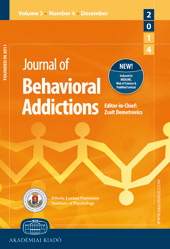Risky Online Behaviors Among Adolescents: Longitudinal Relations Among Problematic Internet Use, Cyberbullying Perpetration, and Meeting Strangers Online
Risky Online Behaviors Among Adolescents: Longitudinal Relations Among Problematic Internet Use, Cyberbullying Perpetration, and Meeting Strangers Online
Author(s): Manuel Gámez-Guadix, Erika Borrajo, Carmen AlmendrosSubject(s): Social psychology and group interaction, Behaviorism, Studies in violence and power, Substance abuse and addiction, Social Informatics
Published by: Akadémiai Kiadó
Keywords: problematic Internet use; Internet addiction; cyberbullying; meeting strangers online; risky behaviors;
Summary/Abstract: This study aims to analyze the cross-sectional and longitudinal relationship between three major risky online behaviors during adolescence: problematic Internet use, cyberbullying perpetration, and meeting strangers online. An additional objective was to study the role of impulsivity–irresponsibility as a possible explanatory variable of the relationships between these risky online behaviors. Methods: The study sample was 888 adolescents that completed self-report measures at time 1 and time 2 with an interval of 6 months. Results: The findings showed a significant cross-sectional relationship between the risky online behaviors analyzed. At the longitudinal level, problematic Internet use at time 1 predicted an increase in the perpetration of cyberbullying and meeting strangers online at time 2. Furthermore, meeting strangers online increased the likelihood of cyberbullying perpetration at time 2. Finally, when impulsivity–irresponsibility was included in the model as an explanatory variable, the relationships previously found remained significant. Discussion: These results extend traditional problem behavior theory during adolescence, also supporting a relationship between different risky behaviors in cyberspace. In addition, findings highlighted the role of problematic Internet use, which increased the chances of developing cyberbullying perpetration and meeting strangers online over time. However, the results suggest a limited role of impulsivity–irresponsibility as an explicative mechanism. Conclusions: The findings suggest that various online risk activities ought to be addressed together when planning assessment, prevention and intervention efforts.
Journal: Journal of Behavioral Addictions
- Issue Year: 5/2016
- Issue No: 1
- Page Range: 100-107
- Page Count: 8
- Language: English

